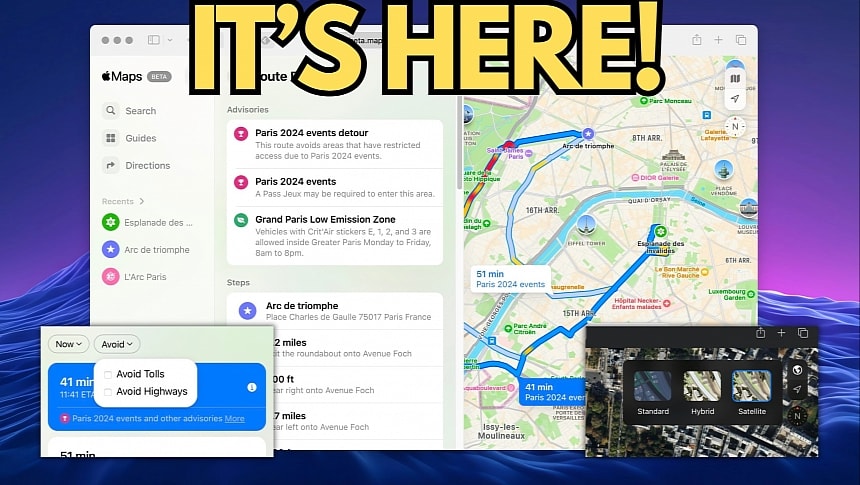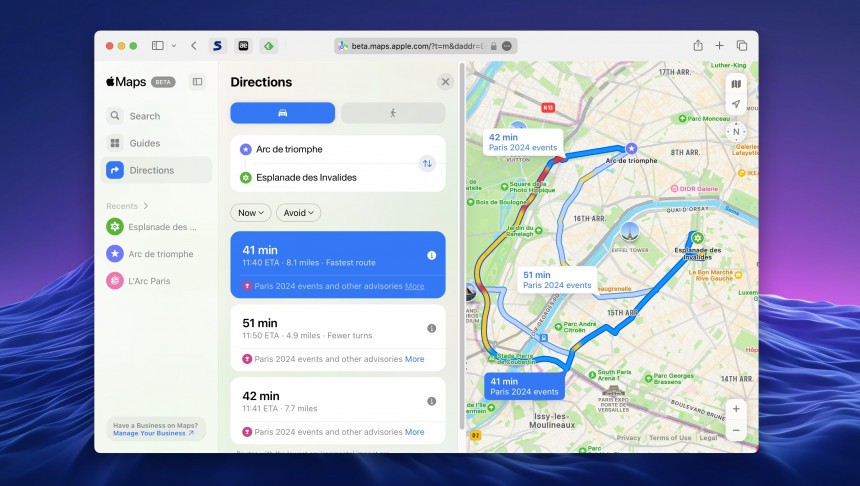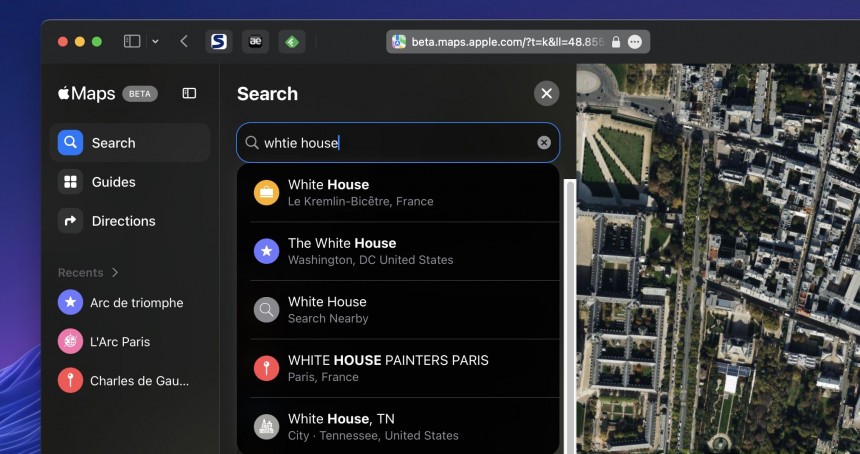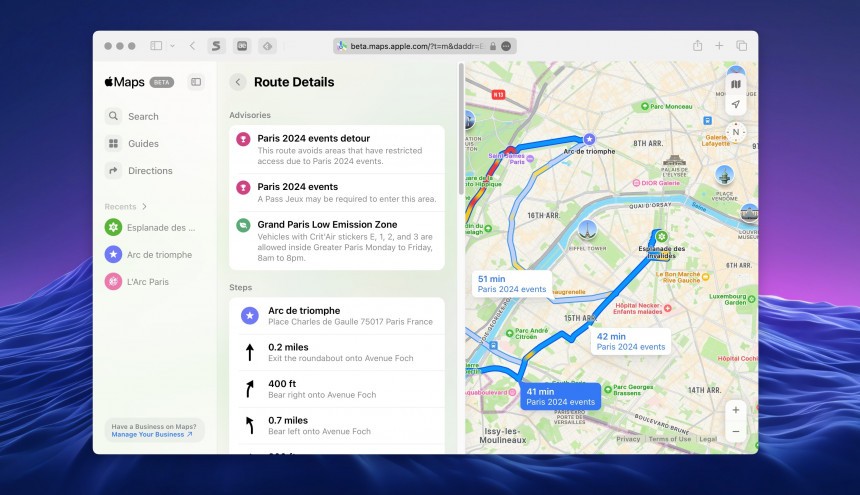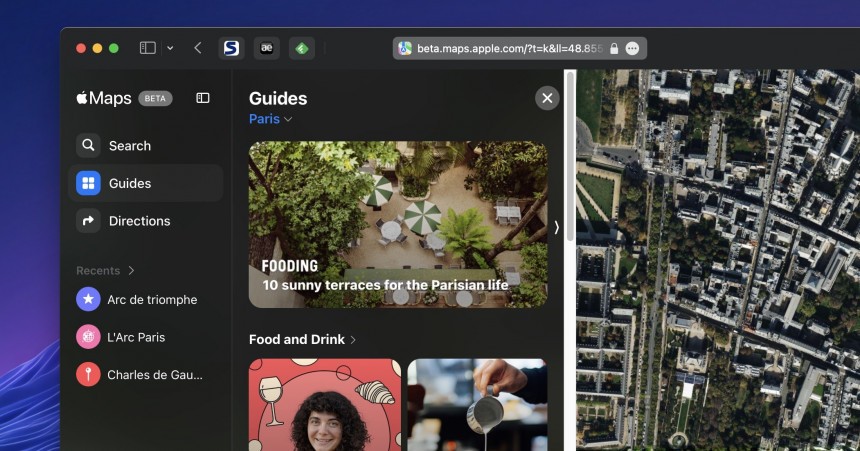Apple has released the first version of the web-based Apple Maps, essentially unlocking its mapping platform for non-Apple users. With this announcement, Apple Maps launches beyond the Apple ecosystem, as anyone can access the service using a browser.
The detailed city experience, which Apple announced earlier this decade, was supposed to be the biggest update in history for Apple Maps. With its release, Apple stepped away from third-party maps and embraced in-house content with details you couldn't find elsewhere, including crosswalks, sidewalks, 3D buildings, trees, and improved navigation.
It was what many people considered the first big demonstration of Apple's anti-Google Maps strategy. The iPhone maker wanted to build a Google Maps competitor, and the detailed city experience was meant to keep users onboard.
The detailed city experience rollout didn't progress at the pace that users expected. It's still available in limited regions, and not even everyone in the United States has it. Apple has proved to be incredibly slow at rolling out this major Apple Maps overhaul, and the more time passed, the more obvious it became that Google Maps was still the top choice in the mapping space, including on Apple devices.
The demise of the Apple Car project was a turning point for Apple in the mapping world. Without a car but still desperately trying to expand in the car space, Apple had only one choice: invest in its products aimed at the automotive sector, namely Apple Maps and CarPlay. It was the moment when I publicly called for Apple to release Apple Maps on Android devices, as limiting the application to Apple devices significantly impacts its expansion in the automotive world.
Apple has recently decided to do the second-best thing after an Android version of Apple Maps: a web-based flavor that can be accessed from any device using a browser. It's probably a matter of time until Apple brings Apple Maps to Android – I asked my contacts at Apple, but it looks like the work on this project is so critical to Tim Cook that nobody wants to comment; however, as we all learned, silence is sometimes the best answer.
The first version of a web-based Apple Maps is here in beta form, allowing users to try the essential feature package on their Windows and Mac computers – Apple doesn't mention Linux in the list of supported devices, but as long as your device can run Google Chrome or another Chromium-powered browser, you're good to go.
The first thing you must keep in mind when testing the new Apple Maps on the web is that it's still a work in progress. Apple calls it a "beta," so some features are missing. The company promises to add them later, but no ETA has been offered (maybe the September event when new iPhones come out is a good moment).
The UI is as clean as you'd expect from an Apple product. It features the company's signature look, fonts, and icons, so navigating the web-based interface is a piece of cake.
I tried Apple Maps in Safari on my Mac, and it felt very responsive and fast, but this isn't necessarily a surprise. Google Maps is also fast on the web, and I wouldn't expect otherwise from Apple Maps.
The main screen is focused on the map, while the left sidebar allows you to search the maps, open guides for the location you explore, and get directions (as in navigation instructions). Apple Maps on the web currently supports three layers: the default map view, hybrid, and satellite, and you can toggle between them from the map view.
Apple Maps in your browser is great for exploration, as you can find all businesses, landmarks, and points of interest already available in the mobile app. Not so much for navigation, as you can configure a route for driving and walking, but considering the application currently lacks support for signing in with an Apple ID, you can't set the directions to your iPhone.
This means you can configure a route but can't use it, as there's currently no way to enable navigation. You get detailed information, including every turn and toll data, and the highlighted route uses the color-coded system to mark sectors with heavy traffic.
Public transit directions are not available, but bus and metro stations are marked on the map. Clicking their icons loads information for each line, including up-to-date arrival times (in regions where they are available).
Apple Maps on the web lacks a 3D mode, so you can't explore regions where the detailed city experience has already been released by admiring the beautiful landmarks added by Apple and available on mobile devices. I assume this is one of the first features to be added in the next update, especially as the DCE is a big part of the new Apple Maps experience. I also expect Apple to add Apple ID integration so users can submit the configured routes to their iPhones.
The next feature update is likely to land before the September event. People familiar with the matter previously revealed that Apple wanted to add support for custom routes built on PCs, allowing users to do the planning phase of a trip on a larger screen. When the route planning is completed, they can send a route to their iPhones and CarPlay via the Apple ID. As a result, the Apple ID integration should be ready before the debut of the next iOS update, when Apple Maps will also receive additional polishing.
Apple Maps currently feels like a basic version of the mobile sibling, but it's still living proof that Apple has finally become committed to building a better Google Maps rival. The next thing it must do is to improve the availability of the DCE, at which point I'm certain that more users would switch from Google Maps to Apple Maps.
Would you jump ship and give up on Google Maps for Apple Maps when the full feature package becomes available worldwide? Let me know what you think in the comment box after the jump.
It was what many people considered the first big demonstration of Apple's anti-Google Maps strategy. The iPhone maker wanted to build a Google Maps competitor, and the detailed city experience was meant to keep users onboard.
The detailed city experience rollout didn't progress at the pace that users expected. It's still available in limited regions, and not even everyone in the United States has it. Apple has proved to be incredibly slow at rolling out this major Apple Maps overhaul, and the more time passed, the more obvious it became that Google Maps was still the top choice in the mapping space, including on Apple devices.
The demise of the Apple Car project was a turning point for Apple in the mapping world. Without a car but still desperately trying to expand in the car space, Apple had only one choice: invest in its products aimed at the automotive sector, namely Apple Maps and CarPlay. It was the moment when I publicly called for Apple to release Apple Maps on Android devices, as limiting the application to Apple devices significantly impacts its expansion in the automotive world.
Apple has recently decided to do the second-best thing after an Android version of Apple Maps: a web-based flavor that can be accessed from any device using a browser. It's probably a matter of time until Apple brings Apple Maps to Android – I asked my contacts at Apple, but it looks like the work on this project is so critical to Tim Cook that nobody wants to comment; however, as we all learned, silence is sometimes the best answer.
The first thing you must keep in mind when testing the new Apple Maps on the web is that it's still a work in progress. Apple calls it a "beta," so some features are missing. The company promises to add them later, but no ETA has been offered (maybe the September event when new iPhones come out is a good moment).
The UI is as clean as you'd expect from an Apple product. It features the company's signature look, fonts, and icons, so navigating the web-based interface is a piece of cake.
The main screen is focused on the map, while the left sidebar allows you to search the maps, open guides for the location you explore, and get directions (as in navigation instructions). Apple Maps on the web currently supports three layers: the default map view, hybrid, and satellite, and you can toggle between them from the map view.
Apple Maps in your browser is great for exploration, as you can find all businesses, landmarks, and points of interest already available in the mobile app. Not so much for navigation, as you can configure a route for driving and walking, but considering the application currently lacks support for signing in with an Apple ID, you can't set the directions to your iPhone.
Public transit directions are not available, but bus and metro stations are marked on the map. Clicking their icons loads information for each line, including up-to-date arrival times (in regions where they are available).
Apple Maps on the web lacks a 3D mode, so you can't explore regions where the detailed city experience has already been released by admiring the beautiful landmarks added by Apple and available on mobile devices. I assume this is one of the first features to be added in the next update, especially as the DCE is a big part of the new Apple Maps experience. I also expect Apple to add Apple ID integration so users can submit the configured routes to their iPhones.
Apple Maps currently feels like a basic version of the mobile sibling, but it's still living proof that Apple has finally become committed to building a better Google Maps rival. The next thing it must do is to improve the availability of the DCE, at which point I'm certain that more users would switch from Google Maps to Apple Maps.
Would you jump ship and give up on Google Maps for Apple Maps when the full feature package becomes available worldwide? Let me know what you think in the comment box after the jump.
